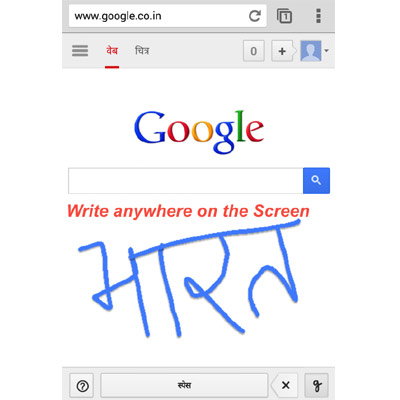Today, Google announced beta support for Hindi handwriting and the ability to switch to a native Hindi experience for Android. These are baby steps to make the Hindi internet simpler to use, the Internet giant claims. The new feature allows users to type in Hindi on a touchscreen, using fingers/a stylus after which it recognises the characters on its own.
 "We believe you should be able to use the internet in Hindi as easily as you read and write today. No matter what kind of handwriting you have, Google can help you find exactly what you’re looking for — so here’s to Handwrite in Hindi, we hope you have as much fun using it as we did creating it!" an official press release said.
"We believe you should be able to use the internet in Hindi as easily as you read and write today. No matter what kind of handwriting you have, Google can help you find exactly what you’re looking for — so here’s to Handwrite in Hindi, we hope you have as much fun using it as we did creating it!" an official press release said.
 "We believe you should be able to use the internet in Hindi as easily as you read and write today. No matter what kind of handwriting you have, Google can help you find exactly what you’re looking for — so here’s to Handwrite in Hindi, we hope you have as much fun using it as we did creating it!" an official press release said.
"We believe you should be able to use the internet in Hindi as easily as you read and write today. No matter what kind of handwriting you have, Google can help you find exactly what you’re looking for — so here’s to Handwrite in Hindi, we hope you have as much fun using it as we did creating it!" an official press release said.
How it works?
Write in Hindi and you shall find on Google Search Handwrite enables you to search by just writing letters with your finger or stylus anywhere on your device’s screen—there’s no keyboard that covers half of the screen and no need for typing.
Here’s how you can start scribbling away
1. Go to www.google.co.in in your mobile browser, tap on “Settings” at the bottom of the screen, go to Search Settings and enable “Handwrite.”
2. Change language in Google products to Hindi. Also add “Hindi” as a Language of Search Results. Note that after you've saved the setting, you may need to refresh the homepage to see the feature. On tablets, the Search settings are available as an option behind the gear icon.
3. Once the feature is enabled, tap the Handwrite icon on the bottom right corner of your screen to activate Handwrite mode. Write a few letters and you’ll see autocomplete options appear below the search box. If one of the options is what you’re looking for, just tap it to search.
4. For longer queries, you can continue writing a string of characters and then use the arrows next to the autocompletions to move the right one into the search box. Remember, you can write anywhere on the screen.
The handwrite feature is currently available on all Android 2.3+ phones, Android 4.0+ tablets and iOS5+ devices.
Author's comment: While there are many handwriting recognition apps and built in software in phones and tablets, the option to make a Google page outside of an app recognise handwriting is awesome. Who knows it could bring handwriting back in style?
Handwrite tips and tricks
Delete letters: Touch the backspace icon at the bottom of the page.
Start over: Touch X in the search box at the top of the page.
Clarify ambiguous characters: When you type a character that could be mistaken for another, like 0 (the number) and O (the letter), a list of options may appear at the bottom of the screen.
Use predictions: To help save you time, a list of predicted queries may appear in the search box as you write. Touch a prediction to search for that query, or touch the arrow to the right of a query to explore related searches.
Include symbols: Try symbols and special characters such as + @ & $.

